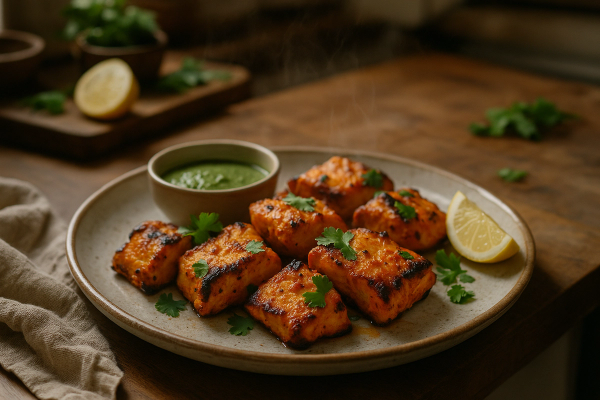Introduction#
Welcome to AllBlogs, your go-to platform for exploring diverse food blogs, travel experiences, tech insights, and lifestyle tips. Today, we turn our culinary spotlight on Ghughra, a beloved snack from Gujarat. Known for its unique flavor and festive presence, Ghughra is more than just a snack – it's a bite-sized piece of cultural heritage. Join us as we delve into its history, recipe, and the stories that make it a favorite among Gujaratis.¶
The Origin of Ghughra#
Ghughra, also known as Gujiya in some regions of India, is a sweet dumpling filled with a mixture of grated coconut, dry fruits, and jaggery or sugar. Its origins can be traced back to the kitchens of Gujarat, where it was traditionally prepared during festivals and special occasions. The name 'Ghughra' comes from the Gujarati word ‘ghughranu,’ meaning a small, pocket-like shape, which perfectly describes this delightful snack.¶
The Perfect Snack#
Ghughra is often enjoyed during festivals like Diwali and Holi, but it is also a common treat during family gatherings and celebrations. Its sweet filling and crispy exterior make it a perfect snack to enjoy with a cup of tea.¶
Recipe: How to Make Ghughra#
Ingredients:#
For the Dough:¶
- 2 cups Maida (Refined flour)
- 4 tbsp Ghee (Clarified butter)
- A pinch of Salt
- Water as needed
For the Filling:¶
- 1 cup Grated coconut (fresh or desiccated)
- 1/2 cup Sugar or grated Jaggery
- 1/2 cup Mixed dry fruits (chopped almonds, cashews, raisins)
- 1 tsp Cardamom powder
- 1 tbsp Poppy seeds (optional)
- Ghee for frying

Method:#
Prepare the Dough:¶
- In a mixing bowl, combine maida, ghee, and a pinch of salt. Mix until the mixture resembles breadcrumbs.
- Gradually add water to form a soft, smooth dough. Cover and let it rest for 30 minutes.
Prepare the Filling:¶
- In a pan, dry roast the grated coconut until it turns light golden brown.
- Add sugar or jaggery and stir until it melts and combines well with the coconut.
- Add the chopped dry fruits, cardamom powder, and poppy seeds. Mix well and remove from heat. Allow the filling to cool.
Shape the Ghughra:¶
- Divide the dough into small balls. Roll out each ball into a small circle (about 3-4 inches in diameter).
- Place a spoonful of filling in the center of each circle. Fold the circle in half to form a semi-circle and press the edges to seal. You can use a fork to create a decorative edge or crimp it with your fingers.
Fry the Ghughra:¶
- Heat ghee in a deep frying pan over medium heat. Fry the ghughra in batches until they turn golden brown and crispy. Drain on paper towels.

Cultural Significance and Anecdotes#
Festivals and Celebrations#
Ghughra holds a special place in Gujarati festivities. During Diwali, the festival of lights, families gather to make these delicious treats, often involving children in the process. The preparation of Ghughra is seen as a bonding activity that brings families closer together.¶
Traditional Rituals#
In some parts of Gujarat, it is customary to prepare Ghughra during Holi, the festival of colors. The sweet and rich filling represents the abundance and joy of the festival, while the crispy exterior symbolizes the golden days of spring.¶
Local Favorites#
In cities like Ahmedabad (અમદાવાદ), Vadodara (વડોદરા), and Rajkot (રાજકોટ), local sweet shops offer their unique variations of Ghughra. Some popular names include ‘Shreeji Sweets’ in Ahmedabad, known for their rich, dry fruit-filled Ghughra, and ‘Rasranjan’ in Vadodara, famous for their coconut and jaggery-filled Ghughra.¶
Best Season to Enjoy Ghughra#
Ghughra is enjoyed year-round, but it is especially popular during the festive seasons of Diwali and Holi. The sweet and crispy treat is perfect for the cooler months when families gather to celebrate and indulge in traditional sweets.¶
Fun and Interesting Stories#
The Tale of the Ghughra Maker#
There’s a charming story about a renowned Ghughra maker in Surat (સુરત) named Kishore Bhai. Known for his meticulously crafted Ghughra, he would tell customers that each piece contained a “sweet surprise.” One day, a curious child asked him what the surprise was. With a twinkle in his eye, Kishore Bhai replied, “The surprise is the love and joy I put into every Ghughra I make.” This story beautifully captures the essence of what makes Ghughra so special.¶
The Ghughra Competition#
In the town of Jamnagar (જામનગર), there’s an annual Ghughra-making competition held during Diwali. Participants showcase their skills in crafting the perfect Ghughra, with prizes awarded for the best taste, texture, and presentation. The event is a community favorite, bringing together people of all ages to celebrate the art of Ghughra making.¶
Conclusion#
Ghughra is more than just a snack; it is a cherished part of Gujarati culture and tradition. From its rich history to its delectable taste, Ghughra offers a delightful experience that brings families together and adds sweetness to celebrations. We hope this blog on AllBlogs has inspired you to try making Ghughra at home and to appreciate the cultural heritage it represents.¶
Stay tuned to AllBlogs for more exciting food blogs, travel tips, tech insights, and lifestyle stories. Happy cooking!¶














